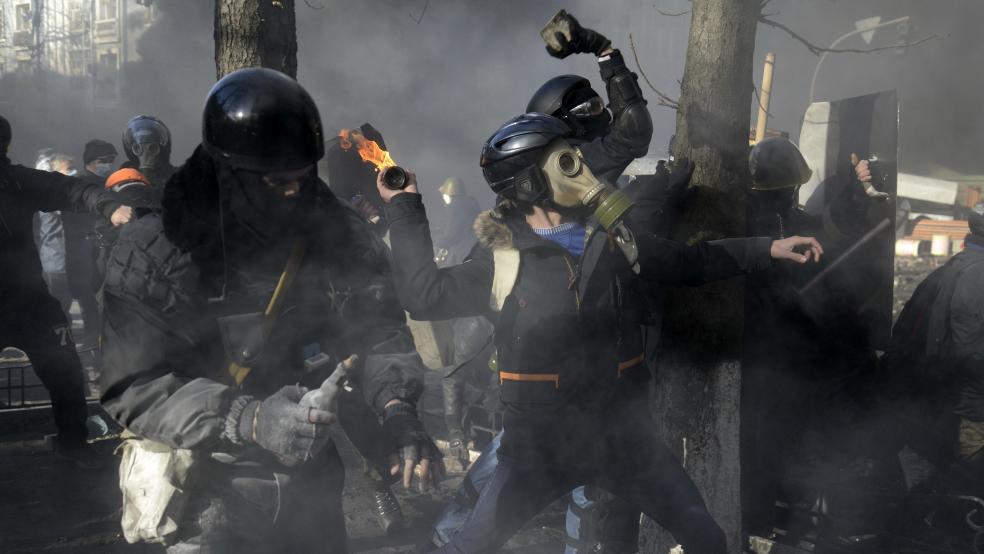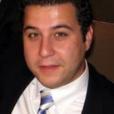Ukrainian President Viktor Yanukovych and opposition leaders agreed to a truce last night, temporarily ending dangerous violent clashes in Kiev’s main square. But the truce was not reached before Ukrainian security forces killed 25 protestors of Yanukovych’s pro-Russia government.
Pictures of fighting in the square and its aftermath are more reminiscent of third-world war zone than a modern European capital. But the severity of those images show just how much is at stake.
Related: Putin Aide Warns U.S. on Ukraine, Says Russia Could Act
On one side is Yanukovych, who favors increased ties with Russia. On the other are the protestors, who want Ukraine to increase ties to the European Union. The protests began when Yanukovych abandoned a trade pact that would have brought Ukraine much closer to the EU; Yanukovych instead took steps to bolster ties with Moscow.
At the center of all of this is Yulia Tymoshenko, the controversial populist former prime minister of Ukraine, who defeated by Yanukovych in the 2010 presidential election. Soon after, she was jailed on trumped up charges, and remains in prison. One of the conditions of the EU trade deal is that she be released, a term Yanukovych would not accept.
For those in the west unfamiliar with Ukrainian politics, all of this is a bit hard to understand. In order to clear up confusion, here’s a guide to the political players and the main issue behind the violence.
Related: Could Russian Nuke Tests Start a New Cold War?
The entire Ukraine crisis comes down to one simple question: will Ukraine’s future be with Russia or the west? If Yanukovych gets his way, Ukraine and Russia will be allies. If Klitschko and the opposition get theirs, Ukraine’s future will be tied to Europe, with hopes of one day entering the European Union.
Yulia Tymoshenko - If there is one person who could calm the opposition, it’s Tymoshenko. European human rights groups have been pushing hard for her release since she was jailed in 2011. It’s not impossible to imagine that if she were freed, it would calm protestors.
As prime minister, Tymoshenko was a vocal advocate of increasing ties with the West and was a constant thorn in Russian President Vladimir Putin’s side. This led to gas pricing disputes in which Gazprom shut off the flow of natural gas through Ukraine, causing a series of energy crises in Europe.
Tymoshenko is loved by Europe, but she’s a divisive figure inside Ukraine. Beginning in 2005, she served as prime minister for five years and was a key part of the Orange Revolution, which brought democratic reforms to Ukraine. But she was always dogged by allegations of corruption in her energy business dealings; Yanukovych used these suspicions to defeat her in the 2010 president election, and then trumped up charges based on those decisions after it. She’s currently serving the second year of a seven-year sentence for embezzlement and tax fraud charges.
Related: Problems at Sochi Reflect Problems in Russia
Vitali Klitschko - Boxing fans know Klitschko as the former heavyweight champ, but he’s been involved in politics for years. Before he officially retired from the sport in 2013, he was elected leader of the Ukrainian opposition party, the Ukrainian Democratic Alliance for Reform in 2012. Now, he serves as the main contact with Yanukovych’s government and, like Tymoshenko, is a strong advocate for closer ties with Europe and the United States.
Earlier this week, Klitschko urged protestors to remain in Kiev's Independence Square despite the violence. As things worsened Wednesday he negotiated the truce.
Viktor Yanukovych - Yanukovych served as prime minster before Tymoshenko, and has been a long-time advocate of Ukraine increasing ties with Russia. Moscow has offered Yanukovych incentives, including a loan bailout, and Putin has publicly backed the embattled president. Putin even urged him to silence the opposition protesting in Independence Square.
Yanukovych’s past is littered with accusations of corruption including allegations of voter fraud in 2004 that led to the Orange Revolution.
Catherine Ashton - As the EU’s chief foreign policy negotiator, Ashton got very close to getting Ukraine to sign the trade deal that began the protests. Since then, she has been powerless to stop the violence, or coordinate a response across the European Union.
George W. Bush - The former president was one of Ukraine’s great champions. He hailed the Orange Revolution as an opportunity for Ukraine to move closer to the west and openly advocated for Ukraine’s membership in NATO. This was one of the main sources of tension between Bush and Putin and led to Russia being more aggressive in Kiev.
So far, Bush has remained silent on the protests.
Vladimir Putin - Putin’s stake in this is simple: he does not want Ukraine or any other country in the former Soviet Union’s primary sphere of influence to increase ties with the west. He went to war with Georgia in 2008 to assert Russian dominance; his weapon in Ukraine has been Russian energy.
Barack Obama - Like Ashton, the Obama administration has yet to articulate a clear policy in Ukraine. One reason could be that, unlike his predecessor, Obama has shown little interest in the region. As violence increased yesterday, the president condemned the Ukrainian government for its brutality.
“I’ve have been watching very carefully and we expect the Ukrainian government to show restraint, to not resort to violence in dealing with peaceful protesters,” Obama said in Mexico. “There will be consequences if people step over the line.”
Top Reads from the Fiscal Times:





